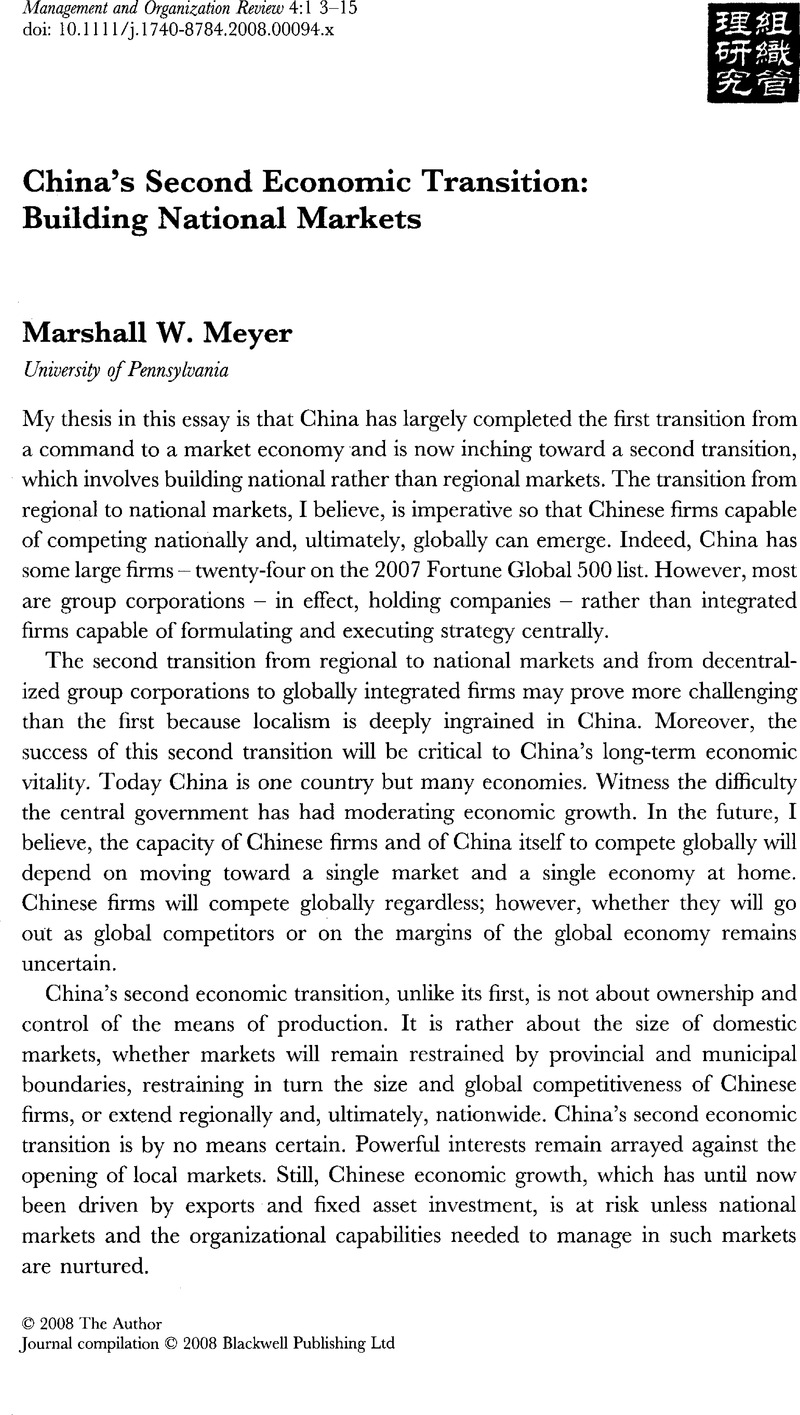Crossref Citations
This article has been cited by the following publications. This list is generated based on data provided by Crossref.
Barney, Jay B.
and
Zhang, Shujun
2008.
Collective Goods, Free Riding and Country Brands: The Chinese Experience.
Management and Organization Review,
Vol. 4,
Issue. 2,
p.
211.
Meyer, Marshall W.
2008.
Editor's Introduction – No Free Lunch: Dilemmas of Product Quality in China.
Management and Organization Review,
Vol. 4,
Issue. 2,
p.
157.
He, Yuanqiong
and
Tian, Zhilong
2008.
Government-Oriented Corporate Public Relation Strategies in Transitional China.
Management and Organization Review,
Vol. 4,
Issue. 3,
p.
367.
Ren, Bing
Au, Kevin Y.
and
Birtch, Thomas A.
2009.
China’s business network structure during institutional transitions.
Asia Pacific Journal of Management,
Vol. 26,
Issue. 2,
p.
219.
Zhang, Jianjun
and
Ma, Hao
2009.
Adoption of professional management in Chinese family business: A multilevel analysis of impetuses and impediments.
Asia Pacific Journal of Management,
Vol. 26,
Issue. 1,
p.
119.
Spigarelli, Francesca
2010.
Chinese Investments in Italy.
International Journal of Asian Business and Information Management,
Vol. 1,
Issue. 1,
p.
54.
Hu, Hao
and
Hafsi, Taïeb
2010.
Strategic Change in a Shifting Institutional Context.
Journal of Change Management,
Vol. 10,
Issue. 3,
p.
293.
Wielemaker, Martin
and
Gedajlovic, Eric
2011.
Governance and capabilities: Asia’s entrepreneurial performance and stock of venture forms.
Asia Pacific Journal of Management,
Vol. 28,
Issue. 1,
p.
157.
Gottwald, Jörn-Carsten
2011.
The Emergence of Southern Multinationals.
p.
281.
Spigarelli, Francesca
2012.
Advancing Technologies for Asian Business and Economics.
p.
119.
Liao, Hailin
Liu, Xiaohui
and
Wang, Chengang
2012.
Knowledge spillovers, absorptive capacity and total factor productivity in China’s manufacturing firms.
International Review of Applied Economics,
Vol. 26,
Issue. 4,
p.
533.
Liu, Xiaohui
Lu, Jiangyong
and
Chizema, Amon
2014.
Top executive compensation, regional institutions and Chinese OFDI.
Journal of World Business,
Vol. 49,
Issue. 1,
p.
143.
Wei, Yingqi
Zheng, Nan
Liu, Xiaohui
and
Lu, Jiangyong
2014.
Expanding to outward foreign direct investment or not? A multi-dimensional analysis of entry mode transformation of Chinese private exporting firms.
International Business Review,
Vol. 23,
Issue. 2,
p.
356.
Lu, Jiangyong
Liu, Xiaohui
Filatotchev, Igor
and
Wright, Mike
2014.
The impact of domestic diversification and top management teams on the international diversification of Chinese firms.
International Business Review,
Vol. 23,
Issue. 2,
p.
455.
Li, Xiaoqing
Zheng, Yu
and
Wang, Catherine L.
2016.
Inter-firm collaboration in new product development in Chinese pharmaceutical companies.
Asia Pacific Journal of Management,
Vol. 33,
Issue. 1,
p.
165.
Lv, Ping
and
Spigarelli, Francesca
2016.
The determinants of location choice.
International Journal of Emerging Markets,
Vol. 11,
Issue. 3,
p.
333.
Filatotchev, Igor
Su, Zhongfeng
and
Bruton, Garry D.
2017.
Market Orientation, Growth Strategy, and Firm Performance: The Moderating Effects of External Connections.
Management and Organization Review,
Vol. 13,
Issue. 3,
p.
575.
Muratova, Yulia
2018.
Domestic Acquisition Experience and the Internationalization of Chinese Firms: The Role of Institutional Heterogeneity.
Management and Organization Review,
Vol. 14,
Issue. 4,
p.
693.
Helveston, John P.
Wang, Yanmin
Karplus, Valerie J.
and
Fuchs, Erica R.H.
2019.
Institutional complementarities: The origins of experimentation in China’s plug-in electric vehicle industry.
Research Policy,
Vol. 48,
Issue. 1,
p.
206.
Ninni, Augusto
Lv, Ping
Spigarelli, Francesca
and
Liu, Pengqi
2020.
How home and host country industrial policies affect investment location choice? The case of Chinese investments in the EU solar and wind industries.
Journal of Industrial and Business Economics,
Vol. 47,
Issue. 4,
p.
531.



